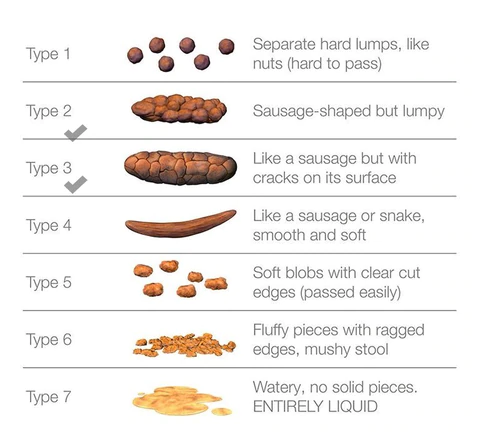20% OFF FIRST 2 SUBSCRIPTION ORDERS
TRY ROCKETO RISK-FREE - MORE DETAILS HERE
Did you know that if your dog is in good health, then their stools should have the same colour, size, and consistency most of the time? 💩
We all know that dog’s are pre-programmed to pick the most embarrassing place possible to poop, like right in the middle of the path as a group of joggers approach, leaving you with no choice but to do the awkward phone check, no eye contact routine. 🙈
Wherever they decide to do their business, it’s a good idea to proactively monitor your dog’s stools, you can then refer to this handy guide for an indication of their current gut health.
In this section, we’ve broken down each of the Four C’s and describe the characteristics of a healthy poop.
The color of your dog’s poop should be a deep, chocolatey brown. Think classic “poop brown.” This indicates there’s no intestinal bleeding. The brown should be relatively uniform throughout and no streaks of other colors/shades should be present.
Vet’s use the “Consistency Scale” when evaluating a dog’s poop. This scale runs from 1-7. A rating of one is a very hard, solid stool, whereas a seven equates to extremely runny, almost entirely liquid diarrhoea.
Ideally, your pup’s poop should be within the 2-3 range. This will vary from time to time depending on their meals, but in general anything too runny indicates an illness.

Plainly put, there should be nothing in your dog’s poop if they are healthy. You may find small traces of fur or food, but only in minute amounts. Anything more than this is a reason to contact your vet.
It’s difficult to completely see the content of your dog’s stool without dissecting it — so be sure to wear gloves or bring a sample to your vet (we explain how to do this below) if you decide to do so.
As with content, your dog’s poop should have no coating. Look at the grass or ground when you pick up your dog’s poop — any sort of sticky or watery remnants means the faeces has a coating. This can mean your pet isn’t digesting food properly.
If you notice alarming poop, you can have two ways of sampling the poop and bringing to vet for further investigation. First is easy – take photo of fresh poop and when using bag or glove inspect the poop yourself. Best idea – it actually bringing the poop sample to your vet. It must not be sitting on the ground for too long before taking the sample.
As usually – it is possible to avoid unpleasant stool and it starts with the gut microbiome. Is easy to understand that most of the ingested diets show their true colours at the end of the digestion process. Right? Although it can be difficult to shift to a ketogenic diet – is it possible to start the transition or to improve even the kibble with the right ingredients.
GUT is a kind, gentle, nourishing support for the digestive system. Organic marshmallows, liquorice, and slippery elm are natural mucolytics to soothe aggravated intestines; paired with psyllium to steady digestion allowing the gut time to absorb key nutrients from the diet. We have a full blog post about philosophy of dog food which you can find right here:
